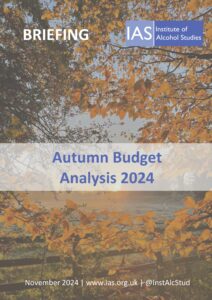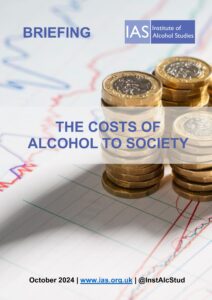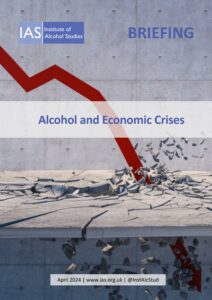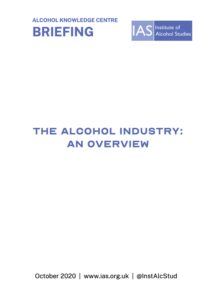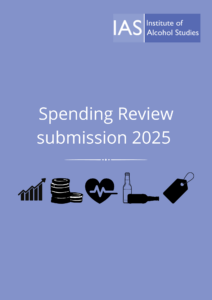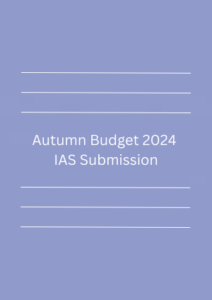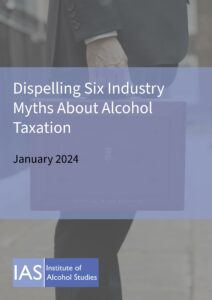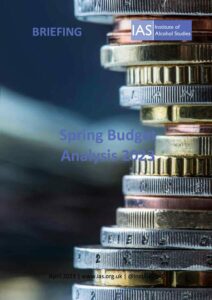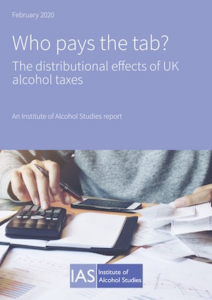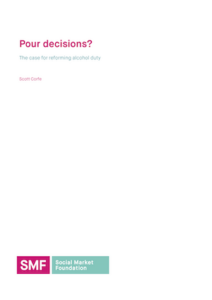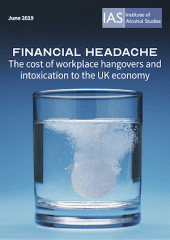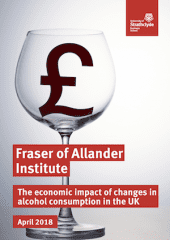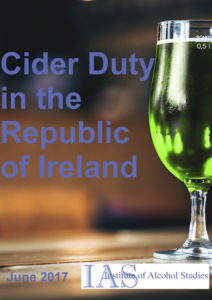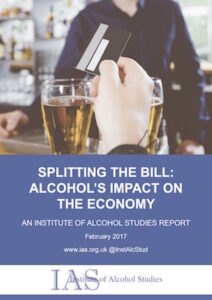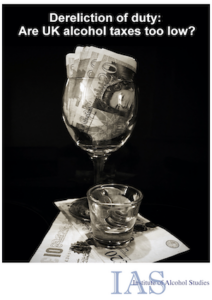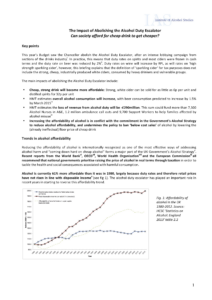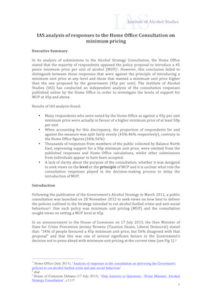On this page
Alcohol harm across the UK has a significant cost associated with it. And due to the extensive impact it has across many aspects of our society, calculating the cost accurately is difficult. Yet there are clear direct costs: to health services, the criminal justice system, and paramedic and police time. These have a direct impact on government finances. And there are also clear indirect costs: from lost productivity due to premature death, the loss of quality of life for the drinker, and drink driving collisions leading to higher insurance rates.
Alcohol harm costs society in England £27.44 billion each year, a 2024 calculation by IAS with support from Balance found. Figures for Scotland, Wales, and Northern Ireland are more dated, with estimates ranging between £6.9 – £11.9 billion total.
Reducing alcohol consumption at a population level is a crucial aspect to reducing both the harm and cost of alcohol to society. Weighing up the economics, there is little convincing evidence to suggest that lower spending would harm the UK economy, and indeed many grounds to believe that reducing drinking could be of economic benefit.
Facts and stats
Cost of alcohol harm in ENGLAND
Overall cost:
£27.44bn
(£485 per head)
Cost Breakdown
Cost per head
NHS & Healthcare: £4.91bn
| Alcohol-related hospital admissions cost: £2,225m | |
| Outpatient visits cost: £533m | |
| Alcohol-related A&E visits cost: £1,070m | |
| Alcohol-related ambulance call-outs cost: £857m | |
| Alcohol-related healthcare appointments cost: £90m | |
| Alcohol dependency drugs costs: £4.7m | |
| Specialist treatment for alcohol costs: £73m | |
| Other alcohol-related healthcare costs: £58m |
Crime & disorder: £14.58bn
4,181,182
estimated alcohol-related crimes
Including reported and unreported crimes:
- 836,758 for criminal damage
- 970,508 for violence against the person
- 2,179,915 for theft
Costs:
Anticipation of crime:
(e.g. money spent on crime detection/prevention such as burglar alarms)
£830.0m
Consequence of crime:
(e.g. cost of stolen or damaged property and emotional harm to the victim)
£9,284.1m
Response to crime:
(e.g. costs to the police and criminal justice system)
£4,470.0m
Wider economy: £5.056BN
| Presenteeism (at work but reduced productivity): £2,206m | |
| Absenteeism (not at work due to illness): £1,754m | |
| Unemployment: £1,096m |
Social services: £2.890BN
Local authority budget estimated to be attributable to alcohol:
Alcohol treatment and support services:
For adults: £171m
For children: £14m
Child social services:
£2,705m
Regional stats
Local Authority stats
Sort:
Search:
| Local Authority | Region | Total cost | Cost per head |
|---|---|---|---|
| Adur | South East | £27.5m | £425 |
| Amber Valley | East Midlands | £59.2m | £468 |
| Arun | South East | £66.3m | £401 |
| Ashfield | East Midlands | £68.3m | £541 |
| Ashford | South East | £70.0m | £525 |
| Babergh | East | £35.7m | £386 |
| Barking and Dagenham | London | £108.0m | £494 |
| Barnet | London | £157.5m | £405 |
| Barnsley | Yorkshire and the Humber | £120.7m | £493 |
| Basildon | East | £103.6m | £552 |
| Basingstoke and Deane | South East | £85.0m | £458 |
| Bassetlaw | East Midlands | £60.0m | £507 |
| Bath and North East Somerset | South West | £81.8m | £425 |
| Bedford | East | £90.6m | £488 |
| Bexley | London | £98.8m | £401 |
| Birmingham | West Midlands | £694.0m | £607 |
| Blaby | East Midlands | £44.0m | £426 |
| Blackburn with Darwen | North West | £82.3m | £531 |
| Blackpool | North West | £116.6m | £828 |
| Bolsover | East Midlands | £38.5m | £479 |
| Bolton | North West | £165.3m | £558 |
| Boston | East Midlands | £40.4m | £571 |
| Bournemouth, Christchurch and Poole | South West | £158.8m | £397 |
| Bracknell Forest | South East | £50.9m | £407 |
| Bradford | Yorkshire and the Humber | £330.9m | £605 |
| Braintree | East | £72.0m | £462 |
| Breckland | East | £61.4m | £432 |
| Brent | London | £153.7m | £453 |
| Brentwood | East | £34.0m | £441 |
| Brighton and Hove | South East | £150.7m | £545 |
| Bristol, City of | South West | £281.3m | £597 |
| Broadland | East | £50.2m | £380 |
| Bromley | London | £148.6m | £450 |
| Bromsgrove | West Midlands | £45.9m | £462 |
| Broxbourne | East | £40.8m | £412 |
| Broxtowe | East Midlands | £46.0m | £415 |
| Buckinghamshire | South East | £218.2m | £393 |
| Burnley | North West | £57.3m | £605 |
| Bury | North West | £103.5m | £534 |
| Calderdale | Yorkshire and the Humber | £116.7m | £564 |
| Cambridge | East | £72.9m | £503 |
| Cambridgeshire | East | £288.9m | £425 |
| Camden | London | £128.8m | £612 |
| Cannock Chase | West Midlands | £39.2m | £390 |
| Canterbury | South East | £86.5m | £553 |
| Castle Point | East | £36.2m | £404 |
| Central Bedfordshire | East | £121.1m | £410 |
| Charnwood | East Midlands | £82.9m | £453 |
| Chelmsford | East | £86.6m | £477 |
| Cheltenham | South West | £61.7m | £519 |
| Cherwell | South East | £75.0m | £464 |
| Cheshire East | North West | £156.9m | £392 |
| Cheshire West and Chester | North West | £156.6m | £438 |
| Chesterfield | East Midlands | £56.9m | £548 |
| Chichester | South East | £47.7m | £383 |
| Chorley | North West | £51.3m | £435 |
| City of London | London | £22.5m | £2,613 |
| Colchester | East | £106.1m | £551 |
| Cornwall | South West | £226.1m | £395 |
| Cotswold | South West | £33.9m | £372 |
| County Durham | North East | £277.1m | £532 |
| Coventry | West Midlands | £199.0m | £580 |
| Crawley | South East | £63.6m | £537 |
| Croydon | London | £188.6m | £483 |
| Cumberland | North West | £131.4m | £480 |
| Dacorum | East | £66.3m | £427 |
| Darlington | North East | £62.7m | £579 |
| Dartford | South East | £67.5m | £578 |
| Derby | East Midlands | £172.0m | £659 |
| Derbyshire | East Midlands | £372.4m | £467 |
| Derbyshire Dales | East Midlands | £26.5m | £370 |
| Devon | South West | £316.0m | £388 |
| Doncaster | Yorkshire and the Humber | £174.1m | £564 |
| Dorset | South West | £151.8m | £398 |
| Dover | South East | £62.1m | £533 |
| Dudley | West Midlands | £149.7m | £463 |
| Ealing | London | £159.0m | £434 |
| East Cambridgeshire | East | £33.1m | £376 |
| East Devon | South West | £54.6m | £359 |
| East Hampshire | South East | £45.2m | £358 |
| East Hertfordshire | East | £59.5m | £395 |
| East Lindsey | East Midlands | £67.5m | £472 |
| East Riding of Yorkshire | Yorkshire and the Humber | £129.4m | £377 |
| East Staffordshire | West Midlands | £46.9m | £377 |
| East Suffolk | East | £104.6m | £424 |
| East Sussex | South East | £241.4m | £441 |
| Eastbourne | South East | £51.4m | £506 |
| Eastleigh | South East | £60.1m | £439 |
| Elmbridge | South East | £54.0m | £387 |
| Enfield | London | £146.4m | £444 |
| Epping Forest | East | £65.5m | £486 |
| Epsom and Ewell | South East | £32.6m | £403 |
| Erewash | East Midlands | £56.6m | £501 |
| Essex | East | £728.3m | £483 |
| Exeter | South West | £66.8m | £517 |
| Fareham | South East | £46.2m | £402 |
| Fenland | East | £52.3m | £509 |
| Folkestone and Hythe | South East | £60.3m | £548 |
| Forest of Dean | South West | £31.5m | £361 |
| Fylde | North West | £31.8m | £388 |
| Gateshead | North East | £106.2m | £541 |
| Gedling | East Midlands | £47.0m | £401 |
| Gloucester | South West | £77.2m | £583 |
| Gloucestershire | South West | £288.5m | £446 |
| Gosport | South East | £38.3m | £466 |
| Gravesham | South East | £62.6m | £586 |
| Great Yarmouth | East | £58.3m | £582 |
| Greenwich | London | £155.9m | £539 |
| Guildford | South East | £65.9m | £458 |
| Hackney | London | £149.3m | £574 |
| Halton | North West | £70.0m | £545 |
| Hammersmith and Fulham | London | £102.3m | £558 |
| Hampshire | South East | £609.5m | £433 |
| Harborough | East Midlands | £35.3m | £360 |
| Haringey | London | £143.3m | £542 |
| Harlow | East | £55.8m | £597 |
| Harrow | London | £102.2m | £392 |
| Hart | South East | £45.0m | £449 |
| Hartlepool | North East | £62.9m | £679 |
| Hastings | South East | £50.6m | £556 |
| Havant | South East | £58.9m | £473 |
| Havering | London | £111.6m | £426 |
| Herefordshire, County of | West Midlands | £82.7m | £441 |
| Hertfordshire | East | £524.8m | £437 |
| Hertsmere | East | £46.6m | £431 |
| High Peak | East Midlands | £42.5m | £466 |
| Hillingdon | London | £135.2m | £444 |
| Hinckley and Bosworth | East Midlands | £45.1m | £397 |
| Horsham | South East | £53.6m | £364 |
| Hounslow | London | £131.7m | £457 |
| Huntingdonshire | East | £71.1m | £391 |
| Hyndburn | North West | £44.0m | £535 |
| Ipswich | East | £82.1m | £588 |
| Isle of Wight | South East | £62.9m | £447 |
| Isles of Scilly | South West | £0.4m | £179 |
| Islington | London | £137.6m | £635 |
| Kensington and Chelsea | London | £87.5m | £608 |
| Kent | South East | £845.4m | £536 |
| King’s Lynn and West Norfolk | East | £67.6m | £437 |
| Kingston upon Hull, City of | Yorkshire and the Humber | £175.6m | £659 |
| Kingston upon Thames | London | £77.0m | £459 |
| Kirklees | Yorkshire and the Humber | £225.0m | £519 |
| Knowsley | North West | £87.6m | £565 |
| Lambeth | London | £186.0m | £586 |
| Lancashire | North West | £575.6m | £466 |
| Lancaster | North West | £65.6m | £462 |
| Leeds | Yorkshire and the Humber | £477.9m | £591 |
| Leicester | East Midlands | £206.0m | £563 |
| Leicestershire | East Midlands | £297.6m | £418 |
| Lewes | South East | £42.1m | £420 |
| Lewisham | London | £147.9m | £493 |
| Lichfield | West Midlands | £36.1m | £338 |
| Lincoln | East Midlands | £69.8m | £682 |
| Lincolnshire | East Midlands | £364.5m | £474 |
| Liverpool | North West | £331.7m | £685 |
| Luton | East | £109.9m | £489 |
| Maidstone | South East | £91.1m | £516 |
| Maldon | East | £25.9m | £389 |
| Malvern Hills | West Midlands | £32.3m | £403 |
| Manchester | North West | £400.9m | £729 |
| Mansfield | East Midlands | £61.1m | £553 |
| Medway | South East | £177.0m | £633 |
| Melton | East Midlands | £20.7m | £401 |
| Merton | London | £85.8m | £398 |
| Mid Devon | South West | £30.5m | £367 |
| Mid Suffolk | East | £41.2m | £398 |
| Mid Sussex | South East | £55.7m | £364 |
| Middlesbrough | North East | £117.6m | £818 |
| Milton Keynes | South East | £143.7m | £499 |
| Mole Valley | South East | £31.2m | £356 |
| New Forest | South East | £75.0m | £426 |
| Newark and Sherwood | East Midlands | £53.0m | £430 |
| Newcastle upon Tyne | North East | £181.5m | £608 |
| Newcastle-under-Lyme | West Midlands | £47.4m | £385 |
| Newham | London | £183.1m | £522 |
| Norfolk | East | £429.5m | £468 |
| North Devon | South West | £39.2m | £394 |
| North East Derbyshire | East Midlands | £45.0m | £439 |
| North East Lincolnshire | Yorkshire and the Humber | £94.7m | £602 |
| North Hertfordshire | East | £56.1m | £420 |
| North Kesteven | East Midlands | £42.2m | £356 |
| North Lincolnshire | Yorkshire and the Humber | £79.4m | £467 |
| North Norfolk | East | £40.3m | £390 |
| North Northamptonshire | East Midlands | £174.7m | £485 |
| North Somerset | South West | £96.4m | £443 |
| North Tyneside | North East | £99.3m | £475 |
| North Warwickshire | West Midlands | £26.5m | £406 |
| North West Leicestershire | East Midlands | £47.2m | £450 |
| North Yorkshire | Yorkshire and the Humber | £232.1m | £375 |
| Northumberland | North East | £146.1m | £454 |
| Norwich | East | £96.1m | £671 |
| Nottingham | East Midlands | £203.1m | £636 |
| Nottinghamshire | East Midlands | £384.0m | £465 |
| Nuneaton and Bedworth | West Midlands | £71.8m | £535 |
| Oadby and Wigston | East Midlands | £21.7m | £376 |
| Oldham | North West | £140.8m | £582 |
| Oxford | South East | £83.8m | £524 |
| Oxfordshire | South East | £303.6m | £418 |
| Pendle | North West | £43.8m | £458 |
| Peterborough | East | £123.0m | £568 |
| Plymouth | South West | £145.4m | £549 |
| Portsmouth | South East | £137.9m | £667 |
| Preston | North West | £82.4m | £558 |
| Reading | South East | £98.1m | £567 |
| Redbridge | London | £136.9m | £442 |
| Redcar and Cleveland | North East | £77.6m | £568 |
| Redditch | West Midlands | £38.8m | £446 |
| Reigate and Banstead | South East | £61.6m | £407 |
| Ribble Valley | North West | £22.2m | £358 |
| Richmond upon Thames | London | £77.6m | £397 |
| Rochdale | North West | £131.9m | £589 |
| Rochford | East | £32.3m | £375 |
| Rossendale | North West | £32.9m | £463 |
| Rother | South East | £39.3m | £420 |
| Rotherham | Yorkshire and the Humber | £137.9m | £518 |
| Rugby | West Midlands | £52.3m | £455 |
| Runnymede | South East | £39.7m | £452 |
| Rushcliffe | East Midlands | £49.4m | £413 |
| Rushmoor | South East | £45.0m | £450 |
| Rutland | East Midlands | £12.8m | £310 |
| Salford | North West | £157.6m | £582 |
| Sandwell | West Midlands | £177.4m | £519 |
| Sefton | North West | £145.0m | £518 |
| Sevenoaks | South East | £53.7m | £445 |
| Sheffield | Yorkshire and the Humber | £280.8m | £506 |
| Shropshire | West Midlands | £122.3m | £377 |
| Slough | South East | £75.0m | £474 |
| Solihull | West Midlands | £100.2m | £463 |
| Somerset | South West | £253.0m | £441 |
| South Cambridgeshire | East | £59.5m | £365 |
| South Derbyshire | East Midlands | £46.6m | £431 |
| South Gloucestershire | South West | £121.0m | £416 |
| South Hams | South West | £31.1m | £349 |
| South Holland | East Midlands | £41.1m | £430 |
| South Kesteven | East Midlands | £59.8m | £416 |
| South Norfolk | East | £55.3m | £388 |
| South Oxfordshire | South East | £51.8m | £345 |
| South Ribble | North West | £53.3m | £479 |
| South Staffordshire | West Midlands | £37.5m | £339 |
| South Tyneside | North East | £77.3m | £523 |
| Southampton | South East | £171.5m | £694 |
| Southend-on-Sea | East | £115.9m | £642 |
| Southwark | London | £165.3m | £540 |
| Spelthorne | South East | £44.6m | £433 |
| St Albans | East | £64.7m | £435 |
| St. Helens | North West | £112.6m | £614 |
| Stafford | West Midlands | £49.8m | £363 |
| Staffordshire | West Midlands | £306.2m | £349 |
| Staffordshire Moorlands | West Midlands | £33.1m | £345 |
| Stevenage | East | £46.0m | £515 |
| Stockport | North West | £135.3m | £458 |
| Stockton-on-Tees | North East | £120.8m | £613 |
| Stoke-on-Trent | West Midlands | £142.8m | £554 |
| Stratford-on-Avon | West Midlands | £52.8m | £388 |
| Stroud | South West | £47.9m | £394 |
| Suffolk | East | £335.5m | £440 |
| Sunderland | North East | £157.3m | £574 |
| Surrey | South East | £486.4m | £403 |
| Surrey Heath | South East | £33.3m | £368 |
| Sutton | London | £87.6m | £418 |
| Swale | South East | £87.3m | £574 |
| Swindon | South West | £110.0m | £470 |
| Tameside | North West | £137.2m | £594 |
| Tamworth | West Midlands | £30.9m | £392 |
| Tandridge | South East | £34.7m | £393 |
| Teignbridge | South West | £47.8m | £354 |
| Telford and Wrekin | West Midlands | £96.0m | £517 |
| Tendring | East | £73.3m | £492 |
| Test Valley | South East | £57.1m | £435 |
| Tewkesbury | South West | £36.0m | £377 |
| Thanet | South East | £91.5m | £650 |
| Three Rivers | East | £37.9m | £403 |
| Thurrock | East | £99.9m | £568 |
| Tonbridge and Malling | South East | £58.5m | £442 |
| Torbay | South West | £74.1m | £531 |
| Torridge | South West | £26.7m | £389 |
| Tower Hamlets | London | £166.4m | £533 |
| Trafford | North West | £110.2m | £468 |
| Tunbridge Wells | South East | £53.9m | £466 |
| Uttlesford | East | £37.8m | £411 |
| Vale of White Horse | South East | £52.1m | £373 |
| Wakefield | Yorkshire and the Humber | £204.7m | £579 |
| Walsall | West Midlands | £149.1m | £525 |
| Waltham Forest | London | £124.3m | £447 |
| Wandsworth | London | £162.3m | £494 |
| Warrington | North West | £101.4m | £480 |
| Warwick | West Midlands | £60.6m | £408 |
| Warwickshire | West Midlands | £263.5m | £440 |
| Watford | East | £49.4m | £482 |
| Waverley | South East | £47.0m | £365 |
| Wealden | South East | £57.9m | £360 |
| Welwyn Hatfield | East | £57.8m | £483 |
| West Berkshire | South East | £62.8m | £388 |
| West Devon | South West | £19.3m | £336 |
| West Lancashire | North West | £43.6m | £372 |
| West Lindsey | East Midlands | £43.7m | £457 |
| West Northamptonshire | East Midlands | £217.3m | £510 |
| West Oxfordshire | South East | £41.5m | £360 |
| West Suffolk | East | £72.7m | £402 |
| West Sussex | South East | £365.7m | £413 |
| Westminster | London | £176.7m | £862 |
| Westmorland and Furness | North West | £89.3m | £393 |
| Wigan | North West | £186.4m | £565 |
| Wiltshire | South West | £200.5m | £390 |
| Winchester | South East | £52.9m | £413 |
| Windsor and Maidenhead | South East | £59.7m | £388 |
| Wirral | North West | £166.4m | £519 |
| Woking | South East | £42.9m | £413 |
| Wokingham | South East | £62.4m | £350 |
| Wolverhampton | West Midlands | £157.4m | £596 |
| Worcester | West Midlands | £44.5m | £430 |
| Worcestershire | West Midlands | £261.4m | £432 |
| Worthing | South East | £52.0m | £466 |
| Wychavon | West Midlands | £54.8m | £412 |
| Wyre | North West | £46.6m | £415 |
| Wyre Forest | West Midlands | £45.2m | £444 |
| York | Yorkshire and the Humber | £91.7m | £455 |
- A 2024 estimate of the cost of alcohol in England by IAS came to £27.44 billion. This used the same method as a Cabinet Office calculation from 2003.
- However, this only represents the ‘external’ cost of alcohol to society – the costs imposed by drinkers upon others – and excludes any private costs.
- Another widely cited range is between £27 and £52 billion. This comes from a study that collated estimates from different countries and found a range between 1.4-2.7% of national income, which Public Health England then applied to UK national income in 2016. Using national income in 2023, this range would be between £37 and £72 billion.
- Examples of private costs are: spending on alcohol, loss of quality of life, lawyers’ fees, and private medical expenditure.
- Examples of external costs of alcohol are: treating health problems, violence and crime suffered as a result of drinking, and economic loss due to premature deaths.
- External costs are important because they are imposed upon third parties without their consent. They are not reflected in the market price.
- There is general agreement that ‘externalities’ such as this justify government intervention, with standard economic theory suggesting alcohol taxes (and thus the consumer) should cover the full price of the social cost of drinking.
- Tangible costs are those that involve the loss of resources that could otherwise be used for spending or investment. These are commonly assigned financial value, and so are easier to estimate. For example, health care and criminal justice costs represent sums of money that would not otherwise have to be paid by the government.
- Intangible costs, such as the fear of crime or the loss of quality of life, by contrast, would not yield resources if eliminated, and are therefore inherently more difficult to value.
- Productivity is lost in a number of ways:
- Presenteeism: Though quantifying its prevalence and magnitude is tricky, evidence suggests that alcohol consumption reduces people’s productivity at work.
- Absenteeism: Studies have found that high levels of drinking, particularly in men, is linked to higher rates of absence from work.
- Unemployment: Studies have found that heavy drinking is associated with a higher risk of unemployment.
- Premature Death: Alcohol-related deaths reduce the size of the labour force. It has been estimated that 167,000 years of working life were lost in England in 2015 due to alcohol, 16% of all working years lost. (PHE, 2016)
- Every year, workplace hangovers are estimated to cost the UK economy between £1.2 and £1.4 billion. (IAS, 2019)
Copy of How much do workplace hangovers cost the UK economy? by The Institute of Alcohol Studies
- The best estimate suggests £14.9 – £15.9 billion is lost in government revenue each year due to alcohol harm in England and Wales alone, consisting of:
- Direct costs to the health services – £4.9 billion
- Costs to the criminal justice system – £4.5 billion
- Social care costs – £2.9 billion
- A shrinking tax base due to a less productive workforce – £2.6 – 3.6 billion (IAS, 2017 and 2024 cost analysis)
- Approximately £12.5 billion is raised via alcohol excise duty each year. This increases to around £15 billion raised after VAT is levied.
- One of the purposes of excise duties is to discourage the consumption of goods that are deemed harmful to consumers’ health or the environment. So, tobacco products, gambling activities, and certain fuels, have duties imposed on them.
- The alcohol industry is a small but not insignificant part of the UK economy, contributing around £46 billion a year to national income, around 2.5% of total GDP. (IAS, 2017)
- This is split between production (e.g. brewers, distillers) and retail (e.g. pubs, bars, and supermarkets). Excluding £2.6 billion in gross capital formation, this includes:
- £17.5 billion from tax
- £3.0 billion from off-trade retailers
- £8.3 billion from on-trade retailers
- £1.6 billion from distributors and wholesalers
- £6.1 billion from exports
- £7.0 billion from domestic producers
- The most significant production is beer for the domestic market and spirits for export.
- The alcohol industry is responsible for around 770,000 jobs, approximately 2.5% of UK employment. (IAS, 2017)
- The vast majority of these are in pubs, clubs, and bars, around 506,000. These are typically part-time and poorly paid.
- By contrast, alcohol producers provide far fewer jobs (around 30,000) but have much higher wages. This is because it is more efficient to produce alcohol than to sell it, due to mechanisation of breweries and distilleries.
- Employment in pubs has remained very stable in recent years, despite many establishments closing. This suggests larger pubs have gained share at the expense of smaller ones.
Employees – public houses and bars, 2001 to 2021 by The Institute of Alcohol Studies
- Reducing alcohol harm requires the reduction of consumption. This has caused alarm among the industry and some politicians; however, it is likely that lower alcohol consumption would boost national income.
- Firstly, lower consumption may occur alongside the purchasing of more expensive drinks – what the industry refers to as ‘premiumisation’ – which could mean spending does not decline.
- Yet even if spending on alcohol declines, spending on other goods is likely to rise to compensate and so boost other industries.
- In the ‘long run’ (when productive capacity is the main constraint on the economy) lower alcohol consumption is likely to have a positive effect by boosting productivity and labour supply, by reducing absenteeism, presenteeism, unemployment, and premature mortality.
- In the ‘short run’ (when a shortage of demand is the main constraint on the economy), the effect is more uncertain and depends critically on what products are purchased instead of alcohol.
- The Office for Budget Responsibility’s analysis suggests that the long run effects are more relevant to the UK economy at the present time.
- Evidence suggests that average alcohol consumption falls slightly during economic crises.
- Crucially however, such crises often see a polarisation of drinking patterns, with certain groups consuming less and others more.
- During the recession of 2008/9 in England, there was a small but statistically significant decrease in frequent drinking (defined as drinking on four or more days in the past week), from 27.1% in 2006 to 23.9% in 2009. (EJPH, 2013)
- Yet there was a rise in heavy episodic drinking among unemployed drinkers.
- During the start of the first COVID-19 lockdown in the UK, although 26% of adults reported consuming less alcohol, the same percentage reported drinking more than usual over the past week. (Drug and Alcohol Dependence, 2021)
- During economic crises, governments may reduce expenditure on public services, which in turn can affect health outcomes.
Briefings
Publications
Blogs

Gone but not forgotten: Why was the Northern Territory’s Minimum Unit Price removed?
1st April 2025

How do economic crises impact levels of alcohol harm, and who is most affected?
18th July 2024

Beyond Personal Harm: The Costs of Alcohol to Society
5th June 2024

Can we increase government revenue by raising alcohol taxes?
26th March 2024

Why do countries with high alcohol taxes still have high rates of alcohol harm?
4th March 2024

Alcohol duty frozen in Autumn Statement: What does this mean?
24th November 2023
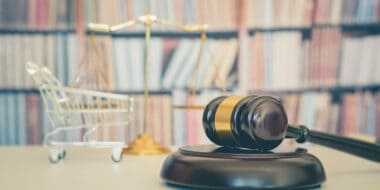
Can alcohol duties be used to reduce the rate of violence injury?
20th June 2023

At what cost? The economic impact of alcohol-related cancer deaths
25th April 2023

